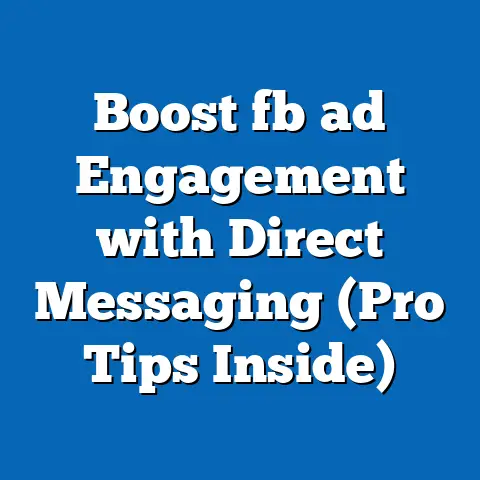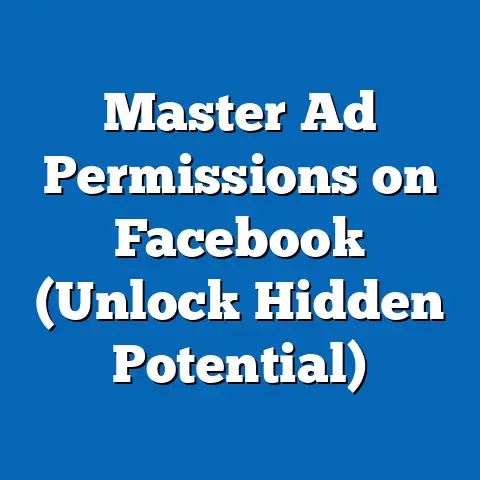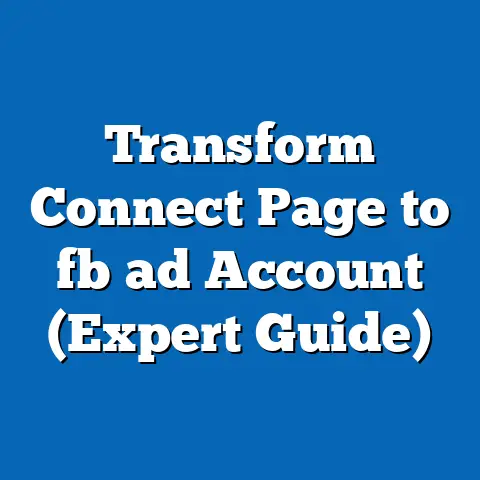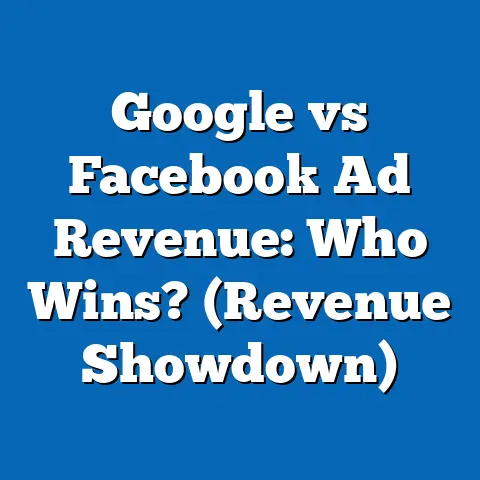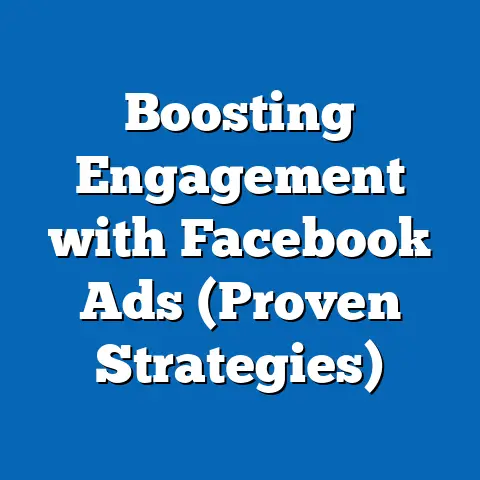Facebook Ads vs. Posts: Which Drives Real Growth? (Expert Insights)
Picture this: I’m sitting in a bustling café, the aroma of freshly brewed coffee swirling around me. Entrepreneurs and creatives are huddled over their laptops, the clatter of keyboards a constant hum. They’re not just catching up on emails; they’re strategizing, planning their next big move in the digital marketing world. And more often than not, the platform at the center of their discussions is Facebook.
But here’s the million-dollar question I often hear: “Should I focus on Facebook ads, or can I get away with just posting organically?” It’s a debate as old as Facebook’s advertising platform itself. Both have their merits, but understanding when to leverage each is crucial for driving real growth.
Understanding the Landscape of Facebook Marketing
Facebook isn’t just a social media platform; it’s a behemoth. With billions of active users worldwide, it’s a digital goldmine for businesses looking to connect with their target audience. I’ve seen firsthand how a well-crafted Facebook strategy can transform a struggling business into a thriving enterprise.
- The Sheer Scale: Facebook boasts over 2.9 billion monthly active users (as of Q1 2024). That’s nearly half the world’s population! This massive reach makes it an unparalleled platform for reaching potential customers, regardless of your niche.
- Engagement is Key: While reach is important, engagement is what truly matters. Users spend an average of 19.6 hours per month on Facebook (Statista, 2023). This presents a significant opportunity to capture their attention and build meaningful connections.
- From Social Network to Marketing Powerhouse: Facebook started as a simple way to connect with friends and family. However, it quickly evolved into a sophisticated marketing platform. The introduction of Facebook Ads Manager transformed the way businesses could target and reach their ideal customers.
The evolution of Facebook as a marketing platform is a story of constant adaptation. The algorithm changes, new ad formats emerge, and user behavior shifts. Staying ahead of the curve requires a deep understanding of both organic and paid strategies.
Takeaway: Facebook’s massive user base and high engagement rates make it a crucial platform for digital marketing. Understanding its evolution is key to leveraging its full potential.
The Power of Facebook Posts
Organic posts are the lifeblood of any successful Facebook page. They’re the free content you share with your followers, designed to build community, foster engagement, and enhance brand authenticity. I’ve seen businesses build loyal followings simply by consistently sharing valuable and engaging content.
- What are Organic Posts? These are the updates, photos, videos, and links you share on your Facebook page without paying for distribution. They appear in the newsfeeds of your followers and, potentially, their friends.
- Building Community: Organic posts are excellent for sparking conversations and building a community around your brand. Ask questions, run polls, and encourage followers to share their thoughts and experiences.
- Authenticity Matters: In today’s digital landscape, authenticity is paramount. Organic posts allow you to showcase your brand’s personality, values, and mission. This helps you connect with your audience on a deeper level.
I remember working with a local bakery that struggled to attract new customers. We focused on creating engaging organic content, sharing behind-the-scenes photos of the baking process, posting mouthwatering pictures of their pastries, and running contests. Within a few months, their Facebook page became a hub for local foodies, and their business saw a significant boost in sales.
Expert Insight: “Organic reach on Facebook may be declining, but organic engagement is still vital for building a strong brand presence and fostering customer loyalty.” – Social Media Examiner
Examples of Successful Organic Strategies:
- Wendy’s: Known for their witty and humorous posts, Wendy’s consistently engages with their audience in a way that feels authentic and relatable.
- GoPro: GoPro uses stunning user-generated content to showcase the capabilities of their cameras and inspire their followers to explore the world.
- National Geographic: National Geographic shares breathtaking photos and videos of nature and wildlife, captivating their audience and promoting environmental awareness.
Takeaway: Organic posts are essential for building community, fostering engagement, and enhancing brand authenticity. Focus on creating valuable and engaging content that resonates with your target audience.
The Mechanics of Facebook Ads
Facebook ads are the paid side of the equation. They allow you to reach a much wider audience than organic posts alone, and they offer incredibly granular targeting options. I’ve used Facebook ads to generate leads, drive sales, and increase brand awareness for businesses across various industries.
- What are Facebook Ads? These are paid advertisements that appear in various locations on Facebook, including the newsfeed, right column, and in-stream videos.
- Types of Facebook Ads:
- Image Ads: Simple ads featuring a single image and text.
- Video Ads: Engaging ads that capture attention with moving visuals.
- Carousel Ads: Ads that allow users to scroll through multiple images or videos.
- Collection Ads: Ads that showcase a collection of products with a visually appealing layout.
- Lead Ads: Ads that allow users to submit their contact information directly from the ad.
- Targeting Options: This is where Facebook ads truly shine. You can target users based on:
- Demographics: Age, gender, location, education, etc.
- Interests: Hobbies, passions, and topics they engage with on Facebook.
- Behaviors: Purchase history, online activity, and device usage.
- Custom Audiences: Upload your own customer lists or create lookalike audiences based on your existing customers.
- Image Ads: Simple ads featuring a single image and text.
- Video Ads: Engaging ads that capture attention with moving visuals.
- Carousel Ads: Ads that allow users to scroll through multiple images or videos.
- Collection Ads: Ads that showcase a collection of products with a visually appealing layout.
- Lead Ads: Ads that allow users to submit their contact information directly from the ad.
- Demographics: Age, gender, location, education, etc.
- Interests: Hobbies, passions, and topics they engage with on Facebook.
- Behaviors: Purchase history, online activity, and device usage.
- Custom Audiences: Upload your own customer lists or create lookalike audiences based on your existing customers.
The ability to target specific audiences is a game-changer. I once worked with an online retailer selling eco-friendly baby products. By targeting parents interested in organic living and sustainable products, we were able to achieve a significantly higher conversion rate compared to a broader targeting approach.
Expert Opinion: “Facebook ads offer an unparalleled level of targeting, allowing businesses to reach their ideal customers with precision and efficiency.” – Neil Patel
Potential Reach and Scalability: Unlike organic posts, which are limited by your follower base and the algorithm, Facebook ads can reach millions of potential customers. You can scale your campaigns as needed, increasing your budget to reach a wider audience and drive more results.
Takeaway: Facebook ads offer powerful targeting options and scalability, allowing you to reach a wider audience and achieve specific marketing goals.
Comparative Analysis: Ads vs. Posts
Now, let’s get to the heart of the matter: which is better, Facebook ads or organic posts? The truth is, there’s no one-size-fits-all answer. The best approach depends on your specific goals, budget, and target audience. I’ve found that a combination of both strategies often yields the best results.
| Feature | Facebook Ads | Facebook Posts |
|---|---|---|
| Reach | High, can reach millions of users | Limited to followers and their friends |
| Targeting | Granular, based on demographics, interests, behaviors, and custom audiences | Limited, based on followers’ interests |
| Cost | Paid, requires a budget | Free, but requires time and effort |
| Control | High, you control the message and targeting | Limited, the algorithm determines who sees your content |
| Engagement | Can drive direct conversions and lead generation | Builds community, fosters engagement, and enhances brand authenticity |
| Time Investment | Requires time for setup, monitoring, and optimization | Requires consistent content creation and community management |
| Effectiveness | Effective for achieving specific marketing goals, like sales and lead generation | Effective for building brand awareness, fostering customer loyalty, and driving organic traffic |
| Feature | Facebook Ads | Facebook Posts |
|---|---|---|
| Reach | High, can reach millions of users | Limited to followers and their friends |
| Targeting | Granular, based on demographics, interests, behaviors, and custom audiences | Limited, based on followers’ interests |
| Cost | Paid, requires a budget | Free, but requires time and effort |
| Control | High, you control the message and targeting | Limited, the algorithm determines who sees your content |
| Engagement | Can drive direct conversions and lead generation | Builds community, fosters engagement, and enhances brand authenticity |
| Time Investment | Requires time for setup, monitoring, and optimization | Requires consistent content creation and community management |
| Effectiveness | Effective for achieving specific marketing goals, like sales and lead generation | Effective for building brand awareness, fostering customer loyalty, and driving organic traffic |
Costs Associated:
- Facebook Ads: The cost of Facebook ads varies depending on your targeting, ad format, and bidding strategy. However, you can set a daily or lifetime budget to control your spending. The average cost-per-click (CPC) on Facebook is around $1-$2, but this can fluctuate significantly.
- Organic Posts: While organic posts are free in terms of direct financial expenditure, they require a significant time investment. Creating high-quality content, engaging with your audience, and monitoring your page all take time and effort.
Measuring Effectiveness:
- Engagement Rates: Measure the percentage of users who interact with your content (likes, comments, shares).
- Reach: Track the number of unique users who see your content.
- Conversion Rates: Measure the percentage of users who take a desired action (e.g., purchase, sign-up).
- Customer Retention: Track how long customers stay engaged with your brand.
Case Study: A local restaurant used both Facebook ads and organic posts to promote their business. They used ads to target potential customers within a specific radius, promoting special offers and new menu items. They used organic posts to share behind-the-scenes photos, customer testimonials, and engage with their followers. This combination of strategies resulted in a 30% increase in sales.
Takeaway: Facebook ads and organic posts each have their own strengths and weaknesses. The best approach is to integrate both strategies, leveraging the power of paid advertising to reach a wider audience and the authenticity of organic content to build community and foster engagement.
Real Growth: What It Truly Means
Real growth isn’t just about vanity metrics like likes and followers. It’s about achieving sustainable, measurable results that contribute to your bottom line. I’ve seen businesses get caught up in chasing likes and shares, only to realize that it’s not translating into actual revenue.
- Defining “Real Growth”: Real growth is defined by metrics that directly impact your business goals, such as:
- Increased Sales: Driving more revenue through Facebook marketing.
- Improved Brand Awareness: Increasing recognition and recall of your brand.
- Higher Customer Loyalty: Retaining existing customers and fostering long-term relationships.
- Lead Generation: Capturing valuable leads for your sales team.
- Measuring Growth:
- Return on Ad Spend (ROAS): Measure the revenue generated for every dollar spent on Facebook ads.
- Customer Acquisition Cost (CAC): Calculate the cost of acquiring a new customer through Facebook marketing.
- Customer Lifetime Value (CLTV): Estimate the total revenue a customer will generate over their relationship with your business.
- Increased Sales: Driving more revenue through Facebook marketing.
- Improved Brand Awareness: Increasing recognition and recall of your brand.
- Higher Customer Loyalty: Retaining existing customers and fostering long-term relationships.
- Lead Generation: Capturing valuable leads for your sales team.
- Return on Ad Spend (ROAS): Measure the revenue generated for every dollar spent on Facebook ads.
- Customer Acquisition Cost (CAC): Calculate the cost of acquiring a new customer through Facebook marketing.
- Customer Lifetime Value (CLTV): Estimate the total revenue a customer will generate over their relationship with your business.
Expert Insight: “Real growth is about aligning your marketing strategies with your business goals and focusing on metrics that truly matter.” – Gary Vaynerchuk
Aligning Marketing Strategies with Business Goals:
- Identify Your Goals: What do you want to achieve with Facebook marketing? Increase sales? Generate leads? Build brand awareness?
- Choose the Right Strategies: Select the strategies that are most likely to help you achieve your goals.
- Track Your Results: Monitor your progress and make adjustments as needed.
Takeaway: Real growth is about achieving sustainable, measurable results that contribute to your bottom line. Focus on metrics that directly impact your business goals and align your marketing strategies accordingly.
Conclusion
So, what’s the verdict? Facebook ads or organic posts? As I’ve highlighted, it’s not an either/or situation. Both strategies have their place in a comprehensive Facebook marketing plan. Organic posts are essential for building community, fostering engagement, and enhancing brand authenticity. Facebook ads offer powerful targeting options and scalability, allowing you to reach a wider audience and achieve specific marketing goals.
The key is to understand the strengths and weaknesses of each approach and integrate them effectively. Use organic posts to build relationships with your followers, share valuable content, and showcase your brand’s personality. Use Facebook ads to reach new customers, drive sales, and generate leads.
As the digital landscape continues to evolve, staying adaptable and embracing new strategies will be crucial for success. The future of Facebook marketing lies in a holistic approach that combines the power of paid advertising with the authenticity of organic content.
Takeaway: A successful Facebook marketing strategy requires a blend of both organic posts and paid ads, tailored to your specific goals and target audience.
Call to Action
Now, I’d love to hear from you! What are your experiences with Facebook ads and organic posts? Which strategies have worked best for your business? Share your thoughts and questions in the comments below! Let’s learn from each other and build a thriving community of Facebook marketers.

